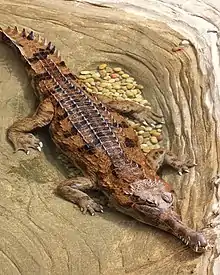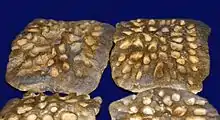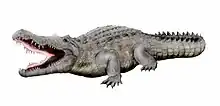| Tomistoma | |
|---|---|
 | |
| False gharial (Tomistoma schlegelii) | |
| Scientific classification | |
| Domain: | Eukaryota |
| Kingdom: | Animalia |
| Phylum: | Chordata |
| Class: | Reptilia |
| Clade: | Archosauromorpha |
| Clade: | Archosauriformes |
| Order: | Crocodilia |
| Family: | Gavialidae |
| Subfamily: | Tomistominae |
| Genus: | Tomistoma S. Müller, 1846 |
| Species | |
Tomistoma is a genus of gavialid crocodilians. They are noted for their long narrow snouts used to catch fish, similar to the gharial. Tomistoma contains one extant (living) member, the false gharial (Tomistoma schlegelii), as well as potentially several extinct species: T. cairense, T. lusitanicum T. coppensi, and T. dowsoni. However, these species may need to be reclassified to different genera as studies have shown them to be paraphyletic, for example: previously assigned species T. taiwanicus from Taiwan, is reclassified to the genus Toyotamaphimeia, and T. dowsoni should be excluded from Tomistoma based on phylogenetic analysis.[2][3][4][5][6]
Unlike the gharial, the false gharial's snout broadens considerably towards the base and so is more similar to those of true crocodiles than the gharial, whose osteology indicated a distinct lineage from all other living crocodilians.[7] However, although more morphologically similar to Crocodylidae based on skeletal features, recent molecular studies using DNA sequencing consistently indicate that the false gharial and by inference other related extinct forms traditionally viewed as belonging to the crocodylian subfamily Tomistominae actually belong to Gavialoidea and Gavialidae.[8][9][10][11][12][13][2][14]

Fossils of extinct Tomistoma species have been found in deposits of Paleogene, Neogene, and Quaternary ages in Uganda, Italy, Portugal, Egypt and India, but nearly all of them are likely to be distinct genera due to older age compared to the false gharial.[15]
The below cladogram of the major living crocodile groups is based on molecular studies and shows the false gharial's close relationships:[9][12][13][2][14]
| Crocodilia |
| ||||||||||||||||||||||||||||||||||||||||||||||||
Here is a more detailed cladogram from a 2018 tip dating study by Lee & Yates simultaneously using morphological, molecular (DNA sequencing), and stratigraphic (fossil age) data that shows the false gharial's proposed placement within Gavialidae, including extinct members:[2]
| Gavialoidea |
| ||||||||||||||||||||||||||||||||||||||||||||||||||||||||||||||||||||||||||||||||||||||||||||||||||||||
| (stem-based group) |
References
- ↑ Rio, Jonathan P.; Mannion, Philip D. (6 September 2021). "Phylogenetic analysis of a new morphological dataset elucidates the evolutionary history of Crocodylia and resolves the long-standing gharial problem". PeerJ. 9: e12094. doi:10.7717/peerj.12094. PMC 8428266. PMID 34567843.
- 1 2 3 4 Lee, M. S. Y.; Yates, A. M. (2018). "Tip-dating and homoplasy: reconciling the shallow molecular divergences of modern gharials with their long fossil". Proceedings of the Royal Society B. 285 (1881). doi:10.1098/rspb.2018.1071. PMC 6030529. PMID 30051855.
- ↑ Iijima, M.; Momohara, A.; Kobayashi, Y.; Hayashi, S.; Ikeda, T.; Taruno, H.; Watanabe, K.; Tanimoto, M.; Furui, S. (2018). "Toyotamaphimeia cf. machikanensis (Crocodylia, Tomistominae) from the Middle Pleistocene of Osaka, Japan, and crocodylian survivorship through the Pliocene-Pleistocene climatic oscillations". Palaeogeography, Palaeoclimatology, Palaeoecology. 496: 346–360. Bibcode:2018PPP...496..346I. doi:10.1016/j.palaeo.2018.02.002.
- ↑ Ito, Ai; Aoki, Riosuke; Hirayama, Ren; Yoshida, Masataka; Kon, Hiroo; Endo, Hideki (April 2018). "The Rediscovery and Taxonomical Reexamination of the Longirostrine Crocodylian from the Pleistocene of Taiwan". Paleontological Research. 22 (2): 150–155. doi:10.2517/2017PR016. ISSN 1342-8144.
- ↑ Burke, Paul M. J.; Mannion, Philip D. (2023-03-16). "Neuroanatomy of the crocodylian Tomistoma dowsoni from the Miocene of North Africa provides insights into the evolutionary history of gavialoids". Journal of Anatomy. doi:10.1111/joa.13846. ISSN 0021-8782. PMC 10273334.
- ↑ Cho, Yi-Yang; Tsai, Cheng-Hsiu (2023-06-29). "Crocodylian princess in Taiwan: Revising the taxonomic status of Tomistoma taiwanicus from the Pleistocene of Taiwan and its paleobiogeographic implications". Journal of Paleontology: 1–14. doi:10.1017/jpa.2023.36. ISSN 0022-3360.
- ↑ Piras, P., Colangelo, P., Adams, D. C., Buscalioni, A., Cubo, J., Kotsakis, T., & Raia, P. (2010). The Gavialis–Tomistoma debate: the contribution of skull ontogenetic allometry and growth trajectories to the study of crocodylian relationships. Evolution & development, 12(6): 568−579.
- ↑ Densmore, L. D.; Owen, R. D. (1989). "Molecular Systematics of the Order Crocodilia". American Zoologist. 29 (3): 831–841. doi:10.1093/icb/29.3.831.
- 1 2 Harshman, J.; Huddleston, C. J.; Bollback, J. P.; Parsons, T. J.; Braun, M. J. (2003). "True and false gharials: A nuclear gene phylogeny of crocodylia". Systematic Biology. 52 (3): 386–402. doi:10.1080/10635150309323. PMID 12775527.
- ↑ Gatesy, J.; Amato, G.; Norell, M.; DeSalle, R.; H. C. (2003). "Combined support for wholesale taxic atavism in gavialine crocodylians". Systematic Biology. 52 (3): 403–422. doi:10.1080/10635150309329. PMID 12775528.
- ↑ Willis, R. E.; McAliley, L. R.; Neeley, E. D.; Densmore Ld, L. D. (2007). "Evidence for placing the false gharial (Tomistoma schlegelii) into the family Gavialidae: Inferences from nuclear gene sequences". Molecular Phylogenetics and Evolution. 43 (3): 787–794. doi:10.1016/j.ympev.2007.02.005. PMID 17433721.
- 1 2 Gatesy, J.; Amato, G. (2008). "The rapid accumulation of consistent molecular support for intergeneric crocodylian relationships". Molecular Phylogenetics and Evolution. 48 (3): 1232–1237. doi:10.1016/j.ympev.2008.02.009. PMID 18372192.
- 1 2 Erickson, G. M.; Gignac, P. M.; Steppan, S. J.; Lappin, A. K.; Vliet, K. A.; Brueggen, J. A.; Inouye, B. D.; Kledzik, D. & Webb, G. J. W. (2012). "Insights into the ecology and evolutionary success of crocodilians revealed through bite-force and tooth-pressure experimentation". PLOS ONE. 7 (3): e31781. Bibcode:2012PLoSO...731781E. doi:10.1371/journal.pone.0031781. PMC 3303775. PMID 22431965.
- 1 2 Hekkala, E.; Gatesy, J.; Narechania, A.; Meredith, R.; Russello, M.; Aardema, M. L.; Jensen, E.; Montanari, S.; Brochu, C.; Norell, M.; Amato, G. (2021). "Paleogenomics illuminates the evolutionary history of the extinct Holocene "horned" crocodile of Madagascar, Voay robustus". Communications Biology. 4 (1): 505. doi:10.1038/s42003-021-02017-0. PMC 8079395. PMID 33907305.
- ↑ "Fossilworks: Tomistoma". fossilworks.org.


